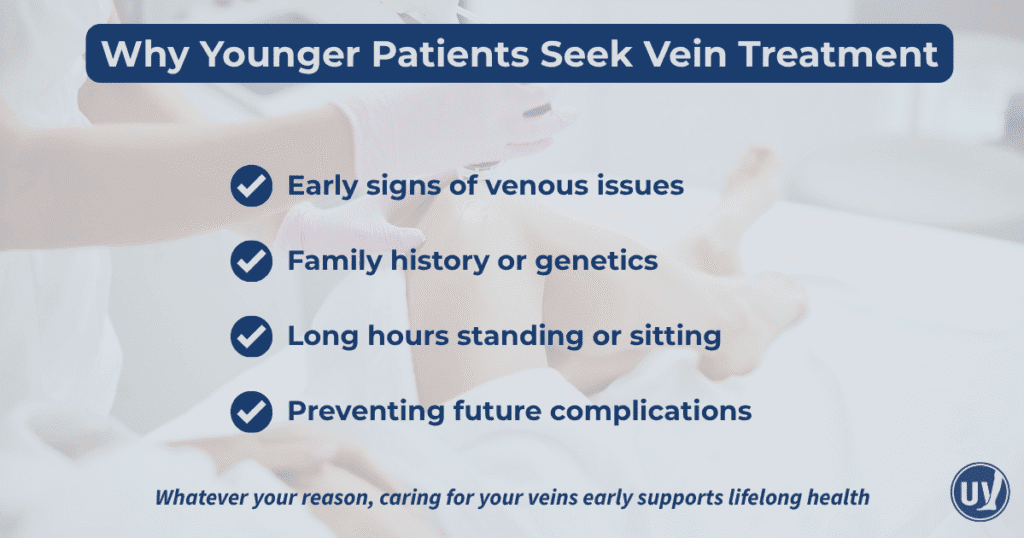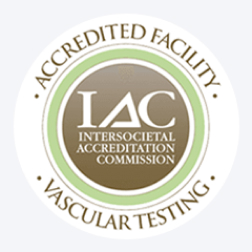Vein issues aren’t just something that happens with age; many younger adults experience them too. While varicose veins are often thought of as cosmetic, they can also indicate underlying vascular problems that, if left unchecked, may lead to discomfort or complications later in life.
Understanding your vein health early is the best way to take control. Simple lifestyle changes like regular exercise, a balanced diet, and mindful habits can help prevent future problems, while modern vein treatments offer safe, effective solutions with minimal downtime.
Whether your concerns are cosmetic, health-related, or both, addressing vein issues proactively ensures better long-term outcomes and improved quality of life. Consulting a vein specialist can provide personalized guidance, empowering you to make informed choices that support both your appearance and your overall vascular health.
Understanding Vein Conditions in Younger Patients
Vein conditions in younger patients are more common than many think. They can stem from various factors, including lifestyle choices and genetics. Early awareness and understanding of these conditions can aid in timely intervention and prevention.
Younger individuals might experience symptoms like swelling, aching, or visible veins. These signs are not merely cosmetic issues. They can indicate potential vein health challenges. Ignoring these symptoms could lead to more serious problems over time.
It is essential for younger patients to grasp the basics of vein anatomy. Veins carry blood from the body back to the heart. When veins function improperly, blood can pool, causing issues like varicose veins. This understanding helps in recognizing when something might be wrong.
Typical vein conditions in younger patients include:
- Żylaki
- Pajączki
- Deep vein thrombosis (though less common in young adults)
Education plays a significant role in empowering young patients. By understanding vein conditions, individuals can seek timely medical advice. This proactive approach ensures both their immediate and future vein health needs are adequately addressed.
Causes and Risk Factors for Vein Issues in Young Adults
Vein issues in young adults can arise from a mix of factors. Genetics play a key role, as a family history of vein conditions increases risk. Knowing about your family’s vein health can offer insights into your own risks.
Hormonal changes, especially during puberty or pregnancy, can also contribute to vein problems. These changes can affect the way blood flows in the veins, potentially leading to issues. Understanding these hormonal influences helps in anticipating possible vein health challenges.
Lifestyle choices like prolonged standing or sitting may lead to vein issues. Activities that limit movement can hinder blood flow, causing veins to enlarge. It’s crucial to recognize how daily habits might impact vein health.
By identifying these factors, young adults can take proactive steps. Small adjustments, such as incorporating regular activity and maintaining a healthy weight, can make a significant difference in vein health.
Recognizing Symptoms: When to Be Concerned
Early recognition of vein symptoms is crucial for timely intervention. Symptoms can often be subtle, making them easy to overlook. However, taking note of any unusual changes in your legs or discomfort is important.
Common symptoms that might indicate vein issues include:
- Swelling in legs or ankles
- Aching or heavy sensation in the legs
- Widoczne żylaki lub pajączki
Experiencing these symptoms regularly should prompt a consultation with a healthcare provider. Ignoring them may lead to progression and complications. Early diagnosis can significantly improve outcomes.
Young adults should monitor changes and seek medical advice if symptoms persist. Proactive steps can help manage symptoms effectively, potentially avoiding more invasive treatments in the future. Remember, understanding your body’s signals is a step towards healthier veins.
Prevention Strategies for Lifelong Vein Health
Prevention is key to maintaining healthy veins throughout your life. Incorporating simple lifestyle habits can greatly reduce the risk of developing vein conditions. Even small changes can have significant long-term benefits for vein health.
Consider these prevention strategies to support vein health:
- Engage in regular physical activity to improve circulation.
- Maintain a healthy weight to avoid unnecessary strain on veins.
- Avoid prolonged periods of sitting or standing.
- Elevate your legs when possible to reduce pressure on veins.
- Wear compression stockings if recommended by a healthcare provider.
Embracing a balanced diet rich in fiber and low in sodium can also support vein health. Fiber helps prevent constipation, which can place stress on veins, while reducing sodium helps manage blood pressure. A well-rounded diet is a cornerstone of prevention.

Stress management techniques like mindfulness and yoga can also promote vein health. These practices improve circulation and overall well-being. Remember, prevention is a lifelong commitment, requiring consistent and proactive attention to your lifestyle and habits.
Cosmetic Concerns vs. Health Risks: What Matters Most?
Varicose veins can be unsightly, leading many to seek cosmetic improvements. However, it’s essential to understand the underlying health implications. Cosmetic concerns and health risks often intertwine with vein conditions.
While addressing appearance is important, it should not overshadow potential health concerns. Veins that appear large or twisted might signal poor blood flow or vein damage. This requires prompt attention from a healthcare provider.
Evaluating both cosmetic and health aspects allows for a comprehensive treatment plan. This plan should address aesthetic desires while prioritizing underlying vein health. Proper assessment can provide a balanced approach to treatment options.
Key considerations for individuals with vein concerns include:
- Severity of visible veins and associated symptoms.
- Presence of any discomfort, swelling, or heaviness.
- Impact of veins on daily life and confidence.
- Understanding potential progression of untreated vein conditions.
Ultimately, taking both cosmetic and health-related factors into account ensures holistic care, promoting both wellness and peace of mind.
Modern Varicose Vein Solutions and Treatment Options
Today’s medical advancements provide a variety of varicose vein solutions. Younger patients can benefit from effective treatments with minimal recovery time.
Sclerotherapy is a popular choice for treating smaller varicose and spider veins. It involves injecting a solution into the vein, causing it to shrink and eventually disappear. This procedure is quick and usually requires no downtime.
Endovenous laser treatment (EVLT) offers a minimally invasive option for larger veins. A tiny laser fiber is inserted into the vein, delivering heat that closes it off. Patients often notice significant improvements with minimal discomfort post-procedure.
Radiofrequency ablation is another modern approach. It uses radiofrequency energy to heat and seal the affected vein, offering relief from symptoms. The procedure is usually performed on an outpatient basis, allowing patients to resume normal activities quickly.
Consider these factors when exploring treatment options:
- Size and severity of varicose veins.
- Desired recovery time and potential downtime.
- Personal goals regarding cosmetic improvement.
- Overall vein health and potential underlying issues.
Each patient’s condition is unique, requiring a personalized treatment plan. Consulting a vein specialist can help identify the most appropriate solution. With the right approach, younger patients can achieve both aesthetic and health-related goals, enhancing their quality of life.
What to Expect: Recovery, Results, and Long-Term Outlook
Vein treatments today are designed for minimal recovery time. Most patients can resume daily activities shortly after the procedure. Each treatment option offers different timelines for healing and visible results.
Younger patients often see quick improvements. Symptoms like swelling and pain tend to diminish rapidly. However, patience is key as full results can take a few weeks to materialize.
The long-term outlook for vein health is positive with appropriate care. Regular follow-ups with a vein specialist can ensure continued well-being. Proactive lifestyle changes support sustained improvements, promoting a healthier vascular system overall.
Empowering Younger Patients: Taking Charge of Your Vein Health
Empowerment begins with understanding your condition and exploring treatment options. Younger patients have the opportunity to address vein issues early. Embracing this proactive approach can lead to long-term benefits for vein health.
Consider these steps to take charge of your vein health:
- Educate Yourself: Learn about symptoms and treatments.
- Seek Expert Advice: Consult a vein specialist.
- Adopt Healthy Habits: Exercise and healthy eating.
- Ask Questions: Be actively involved in your care decisions.
Taking these steps can help you become an informed advocate for your health. Building a supportive healthcare team further assists in managing and maintaining your well-being.
Prioritizing Vein Health for a Better Future
Taking care of your veins early is key to maintaining comfort, confidence, and overall wellness. By understanding your unique needs and taking preventive steps, younger patients can reduce the risk of complications and support long-term vein health.
Vein care isn’t just about appearance; it’s an investment in your overall well-being. Partnering with a vascular specialist allows you to make informed choices, combine preventive strategies with effective treatments, and stay proactive about your health.
Schedule a consultation at United Vein & Vascular Centers today to take the next step toward healthier veins and a more confident, vibrant future.
Często zadawane pytania
Yes! Genetics, prolonged standing or sitting, and lifestyle factors can contribute to vein issues in younger adults, even if they are often associated with aging.
No. While cosmetic improvement is a benefit, vein treatments also address underlying vascular issues, improve circulation, reduce discomfort, and prevent future complications.
Regular exercise, maintaining a healthy weight, avoiding prolonged sitting or standing, and consulting a vein specialist for early evaluation can all help maintain healthy veins.


